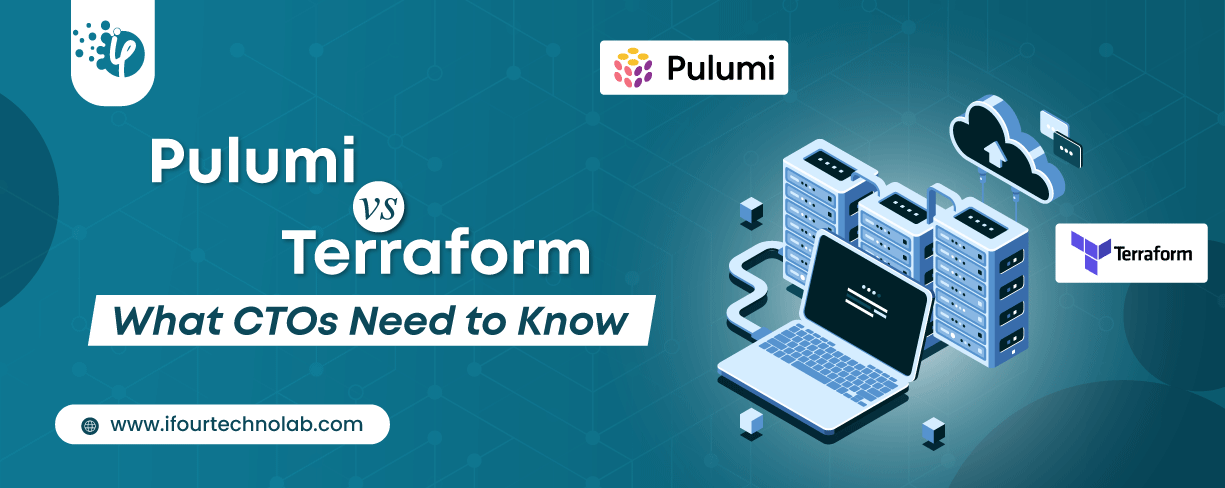How to Do Forecasting in Power BI (Steps & Accuracy Metrics)
Remember our last guide - Power BI forecasting? It revealed things that truly blocks accuracy, both structural and situational. Now it's time to take the next step. Knowing Power...
Listening is fun too.
Straighten your back and cherish with coffee - PLAY !

Automation isn’t just a trend anymore. It’s a must-have for any business relying on the Cloud. As the firm grows, cloud infrastructure gets more complex. So, choosing the right Infrastructure as Code tool becomes essential.
It’s a technical and strategic decision which CTOs used to take, generally.
In this blog, we’re exploring Pulumi vs Terraform, the top two Infrastructure as Code tools for Azure. We’ll break down what CTOs should understand and when to use each for automating the cloud.
Both are popular Azure IaC tools that help you automatically set up your cloud infrastructure, like servers, databases, and networks, instead of doing it manually.
Let me keep it simple. Terraform is best suited for those with limited programming skills, while Pulumi is ideal for experienced programmers.
| Tool | How It Works | Who It’s Best For |
|---|---|---|
| Terraform | Uses its own simple language (HCL) | Easier for beginners or non-developers |
| Pulumi | Uses real programming languages (like Python, TypeScript, C#) | Better for developers and scalable projects |
Build intelligent cloud solutions with our Azure AI Consulting Services .
Even though Pulumi has distinct advantages to offer, particularly for developers comfortable with mainstream programming languages, Terraform currently dominates the IaC market due to its maturity, extensive ecosystem, and established user base.
To learn how to build and manage complex cloud apps using Terraform, you can check this out.
Now that you know the main differences between Pulumi and Terraform Azure Infrastructure tools, let's take a deep dive and learn the distinctions the other way around.
| Category | Pulumi | Terraform |
|---|---|---|
| Developer Experience | You get full IDE support, real code for infra, built-in testing, and reusable components - making onboarding faster and collaboration smoother. | You work with HCL, which is declarative and less flexible for developers used to general-purpose languages. |
| Cloud-Native Power | Pulumi gives full Kubernetes API coverage, GitOps workflows, along with Helm support. This helps your team build cloud-native apps effortlessly. | Even Terraform supports Kubernetes, but lacks deep integration and type safety (like Pulumi provides). |
| Enterprise Features | As a CTO, you'll benefit from audit logs, encrypted secrets, modular infra, and policy-as-code, all built for scale and governance. | Terraform offers enterprise features too, but Pulumi's developer-first approach makes it more flexible. |
| Migration & Integration | Using Pulumi, your team can convert code, reference state, and migrate easily, so you don't have to start over. | Terraform doesn't offer native migration tools to Pulumi or other platforms. |
Pulumi is especially strong if you're building custom Azure Cloud solutions, integrating with CI/CD pipelines, or planning multi-cloud strategies.
Pulumi and Terraform are both popular IaC (Infrastructure as Code) tools, but they scale differently.
Too many devices, not enough control? Our Azure IoT Hub Consulting Services fix that.
Since automation is a necessary aspect at every level of operations, these days, you, as a CTO, should be exploring what are the best cloud automation solutions to go with.
So, here comes the Azure Infrastructure as Code tools to explore.
You have probably heard about different Azure IaC tools, but Pulumi and Terraform are definitely the top picks for many Azure DevOps professionals.
Both are great tools as they help you automate cloud infrastructure so your team doesn’t have to manually set up servers, databases, or networks every time.
But here’s the key difference:
Terraform uses its own custom language called HCL. It’s simple at first, but as your infrastructure grows, it can get messy. You’ll find yourself repeating code, struggling with logic, and dealing with scripts that are thousands of lines long.
Whereas Pulumi lets you write infrastructure code using real coding languages - like C#, Java, Python, GO, and JavaScript. That means your developers can use the same tools they already know. They can write cleaner code, reuse libraries, and build smarter automation.
Let me give you a few examples:
| Language | What It Unlocks in Pulumi |
|---|---|
| Python | With Python, you can use Pandas or NumPy for data-heavy infrastructure logic. |
| JavaScript/TypeScript | With JavaScript, you get access to npm packages and async workflows. |
| Java | With Java, you get access to enterprise-grade frameworks. |
| Go | Using GO benefits you with high-performance concurrency. |
| .NET | With .NET, you can plug right into your existing enterprise systems. |
| YAML | Even YAML is supported if you want something simpler. |
Now, what does this mean in the real world?
Pulumi gives your team full support in their IDE - like auto-complete and error checking. It has built-in testing frameworks, lets you create custom infrastructure components, and apply consistent settings across your cloud setup. That’s a huge win for developer productivity.
Managing hybrid data feels messy? Our Azure Arc Data Services bring it all together.
So to sum it up: Terraform is great for getting started. Pulumi is built for scale, flexibility, and long-term success - especially if your team already knows how to code.
If you’re thinking about future-proofing your DevOps strategy, Pulumi’s worth a serious look.
Here are some of the best use cases of Pulumi and Terraform across industries, important to know for CTOs.
Terraform: Used to provision secure cloud infrastructure for EHR systems, HIPAA-compliant environments, and multi-cloud deployments.
Pulumi: Ideal for integrating infrastructure with custom healthcare apps using real code (e.g., Python), enabling better automation and compliance tracking.
Terraform: Commonly used for managing infrastructure across hybrid cloud setups, ensuring consistent environments for trading platforms or banking apps.
Pulumi: Preferred when teams need to embed infrastructure logic into existing financial applications, or enforce strict policy-as-code for compliance.
Terraform: Great for scaling infrastructure quickly during traffic spikes (e.g., Black Friday), using reusable modules and multi-cloud support.
Pulumi: Useful for building dynamic infrastructure tied to microservices, enabling faster feature rollouts and CI/CD integration.
Manual tasks slowing you down? Automate them with Power Automate Consulting Services .
Terraform: Used to manage IoT infrastructure, edge computing environments, and centralized monitoring systems.
Pulumi: Helps when infrastructure needs to be tightly integrated with custom-built factory automation software or analytics platforms.
Terraform: Ideal for setting up repeatable environments quickly, especially for MVPs or multi-tenant SaaS platforms.
Pulumi: A better fit when developers want to manage infrastructure using the same languages they use to build the product (e.g., TypeScript, Go).
So that's all from this informative blog. Hope this helps you decide the best one depending on your strategic requirements.
Pulumi is developer-friendly, while Terraform is battle-tested. The right choice depends on your team's comfort and your project's needs. Looking for assistance? Partner with iFour, an eminent Azure Managed Services Provider with 120+ certified Microsoft Professionals.
Pulumi and Terraform - both are prominent Infrastructure as Code (IaC) tools taking the world into a new era of automated, scalable, and developer-friendly cloud infrastructure.
This blog has discussed the key differences between Pulumi and Terraform and explored the reasons that clarify CTOs when to choose what.
Pulumi is built for modern cloud-native workflows. So, if your team is working with Kubernetes, Pulumi could support you with full API coverage and native Helm support. It even helps your team with tools that convert YAML into Pulumi code.
Whereas Terraform is your go-to choice if you are looking for a large set of prebuilt modules and extensive documentation. It is favored by Fortune 500s due to its vast community.
So, whether you're leaning toward Pulumi for its developer-friendly approach or sticking with Terraform for its maturity and ecosystem, what matters most is aligning your choice with your team's strengths and your business goals.
We hope you found this article helpful. Until next time - build smart, scale fast!
Yes, if you're a developer who prefers writing in real programming languages like Python or TypeScript, Pulumi feels more natural.
Use Pulumi when your project needs flexibility, custom logic, or tight integration with app code.
Yes, Pulumi supports enterprise features like policy-as-code, audit logs, and secret management - just like Terraform.
Pulumi offers deeper Kubernetes support with full API coverage and better type safety, making it great for cloud-native teams.
Terraform is easier for beginners. Pulumi is better if you're already familiar with coding.
Yes, Pulumi can reference existing Terraform state, so you don't have to start from scratch.
Pulumi is flexible and developer-friendly. Terraform is mature, widely adopted, and easier for non-developers.
Pulumi is more cloud-native, especially for Kubernetes and GitOps workflows.

Remember our last guide - Power BI forecasting? It revealed things that truly blocks accuracy, both structural and situational. Now it's time to take the next step. Knowing Power...

Security has always been a major concern. Your company spends millions on cybersecurity tools, and guess what? You’re still vulnerable. When you're working in the cloud, especially...

Automation isn’t just a trend anymore. It’s a must-have for any business relying on the Cloud. As the firm grows, cloud infrastructure gets more complex. So, choosing the right Infrastructure...